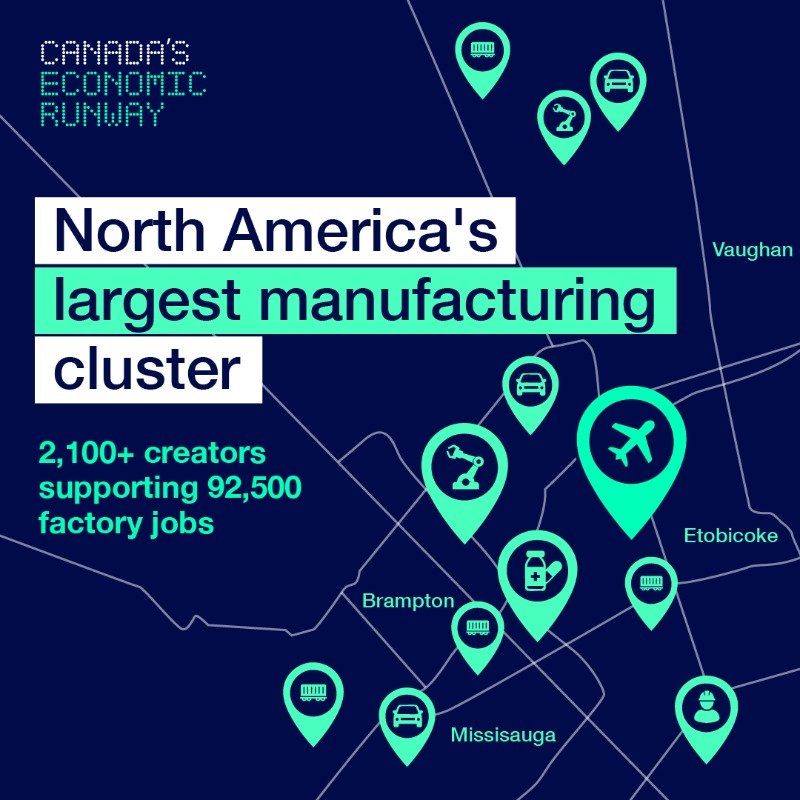Chris led the development of a report profiling the Pearson Economic Zone as a cornerstone of Ontario’s advanced manufacturing economy.
Produced in partnership with the Trillium Network for Advanced Manufacturing, the study provides a detailed analysis of the zone’s industrial footprint—home to more than 1,600 firms, 66,000 advanced manufacturing jobs, and $15 billion in annual economic output. With strengths in aerospace, electronics, machinery, and fabricated metals, the zone supports dense supplier networks, export connectivity, and one of the largest manufacturing workforces in the province.
The report highlights growing pressures on industrial land, rising costs, and the need for coordinated planning across jurisdictions. It outlines strategic actions to protect the zone’s competitiveness and reinforce its role as a national hub for innovation, production, and investment.
Pearson Econonmic Zone Characterization
Chris led the development of report providing a characterization of the Pearson Economic Zone - one of Ontario’s most vital yet underrecognized economic engines.
Developed in partnership with Deloitte and a network of regional and industry stakeholders, the report analyzes the 200 km² employment zone surrounding Toronto Pearson International Airport—home to over 500,000 jobs and generating $70 billion annually. As a hub for manufacturing, logistics, trade, and innovation, the zone plays a critical role in Ontario’s economy.
The report outlines urgent challenges—land scarcity, infrastructure pressure, and fragmented planning—while identifying strategic opportunities to strengthen the zone’s role as a 21st-century jobs and innovation hub. It offers a clear roadmap for investment, policy alignment, and regional collaboration.
York Region Post-Secondary Investment Attraction Strategy
To support York Region’s growing economy and talent needs, Chris initiated and led the development of the Region’s first Post-Secondary Investment Attraction Strategy—a framework to expand access to higher education and strengthen the region’s innovation capacity.
Developed in collaboration with York Region’s nine local municipalities and informed by input from major employers, academic institutions, and policy leaders, the strategy identified opportunities to attract a range of post-secondary investments—from targeted learning centres addressing local skill gaps to the establishment of a full-scale research campus.
The strategy also introduced a policy framework to guide regional involvement in future post-secondary partnerships, ensuring alignment with long-term planning, infrastructure priorities, and economic development objectives.
Pearson Eco-Business Zone Materials Exchange Program
As part of the Partners in Project Green strategy, Chris led the development of the Materials Exchange Program—an initiative designed to help businesses around Toronto Pearson identify opportunities to transform waste into usable feedstock, advancing both sustainability and industrial innovation.
To inform the program’s design, Chris conducted a global scan of successful materials exchange models—analyzing the economic and policy conditions that supported scale and adoption. Building on these insights, he developed a business model tailored to the Pearson employment zone and secured funding to move the initiative forward.
The program continues to operate as a practical tool for companies looking to reduce disposal costs, improve resource efficiency, and explore circular economy opportunities within their supply chains.
Greater Toronto Area Spills Assessment
To strengthen emergency response and environmental protection in the Region of Peel, Chris led the development of a web-based Spill Decision Support System—a tool designed to help responders manage chemical and oil spills with greater speed, accuracy, and coordination.
Developed through a public-private partnership, the system integrated multiple data sources—including historical spill records, chemical storage inventories, and storm sewer infrastructure—into a user-friendly platform that could be deployed in the field. The tool enabled responders to trace spills from origin to watercourse entry points, improving incident tracking, source identification, and response planning.
Chris managed all aspects of the project, from securing funding and convening four municipal partners to overseeing the consulting team through technical design and implementation. The result was a practical, field-ready solution that improved regional spill response and safeguarded local ecosystems.

